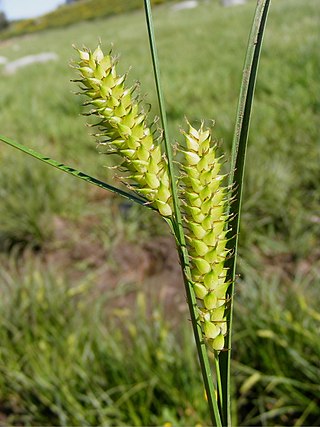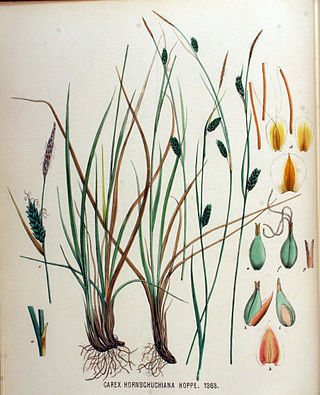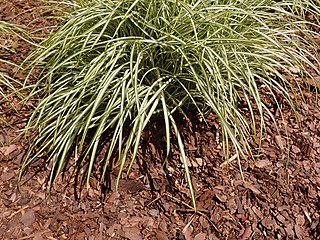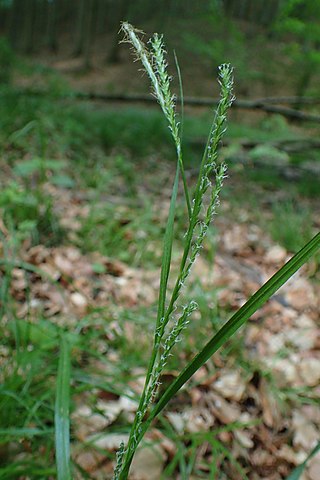
Carex pendula is a large sedge of the genus Carex. It occurs in woodland, scrubland, hedges and beside streams, preferring damp, heavy clay soils. It is sometimes grown as a garden plant because of its distinctive appearance.

Carex vesicaria is an essentially Holarctic species of sedge known as bladder sedge, inflated sedge, and blister sedge. It has been used to insulate footwear in Norway and among the Sami people, and for basketry in North America.

Elachista gleichenella is a moth of the family Elachistidae found in most of Europe.

Carex sylvatica is a species of sedge found in deciduous woodlands across Europe. It typically reaches 60 cm (24 in) tall, and has an inflorescence made up of 3–5 pendent female spikes and a single male spike. It is also used as a garden plant, and has been introduced to North America and New Zealand.

Carex muricata, the rough sedge or prickly sedge, is a species of Carex found in Europe and western Asia as far as the Himalayas. It has been introduced elsewhere. Poorly studied, Carex muricata is considered a species aggregate. The aggregate has been subject to a great deal of taxonomic confusion over the years and has yet to be fully resolved.

Carex remota, the remote sedge, is a species in the genus Carex, native to Europe, the Atlas Mountains in Africa, and western Asia. It is a riparian forest specialist. It is known as one of the most frequently hybridizing species of Carex, forming hybrids with C. appropinquata, C. arenaria, C. brizoides, C. canescens, C. divulsa, C. echinata, C. elongata, C. leporina, C. otrubae, C. paniculata, and C. spicata.

Carex dioica, the dioecious sedge, is a species of flowering plant in the genus Carex, native to Iceland, the Faroes, Svalbard, nearly all of Europe, western Siberia, and the Altai. It prefers to live in calcareous fens.

Carex hostiana, the tawny sedge, is a species of flowering plant in the genus Carex, native to Europe and northeast Canada, and extinct in Massachusetts. It is a member of the Carex flava species complex.

Carex ornithopoda, called the bird's foot sedge, is a species of flowering plant in the genus Carex, native to most of Europe, and Anatolia. A variegated cultivar is commercially available.

Carex strigosa, the thin-spiked wood sedge, is a species of flowering plant in the genus Carex, native to Europe and the Caucasus region. Its diploid chromosome number is 2n=66.

Carex breviculmis, called the Asian shortstem sedge, is a species of flowering plant in the genus Carex, native to Asia from the Indian subcontinent to Southeast Asia, China, Taiwan, Korea, Japan, north as far as Khabarovsk Krai, and Malesia, New Guinea, Australia, Norfolk Island and New Zealand. It has been introduced to the US state of Mississippi. Typically found in forests, it is quite shade tolerant.

Carex lachenalii, called the twotipped sedge and hare's foot sedge, is a species of flowering plant in the genus Carex, native to temperate and subarctic North America, Greenland, Iceland, Europe, and Asia, and the South Island of New Zealand. Its diploid chromosome number is 2n=64, with some uncertainty.

Carex maritima, called the curved sedge, is a species of flowering plant in the genus Carex, with a bipolar distribution in mountains and cold regions. It dispersed in the Pleistocene from the northern to the southern hemisphere.

Carex elongata, the elongated sedge, is a species of flowering plant in the family Cyperaceae, native to Europe, the Caucasus, western Siberia, Kazakhstan, and the Altai. It occurs in boggy woodland and wet meadows, where it forms dense tussocks up to about 1 m tall.

Carex testacea, the orange New Zealand sedge, is a species of flowering plant in the family Cyperaceae, native to New Zealand. Prized for its colourful foliage, which provides both summer and winter interest, it is widely available commercially.

Carex trifida, the mutton-bird sedge, is a species of flowering plant in the family Cyperaceae, native to Macquarie Island of Australia, the South Island, the Antipodes Islands, and the Chatham Islands of New Zealand, southern Chile, and the Falkland Islands. There are a number of cultivars, including 'Rekohu Sunrise', 'Glauca', and 'Chatham Blue'.

Carex flagellifera, the weeping brown sedge or Glen Murray tussock sedge, is a species of flowering plant in the family Cyperaceae. It is native to Tasmania, New Zealand, and the Chatham Islands, and it has been introduced to the Kermadec Islands and Great Britain. There are a number of cultivars, including 'Auburn Cascade', 'Coca-Cola', 'Frosted Curls', 'Kiwi', 'Rapunzel', and 'Toffee Twist'.
Carex chathamica is a species of sedge in the family Cyperaceae, native to the Chatham Islands of New Zealand. Grey-backed storm petrels nest in its tufts.

Carex leersii, the grassland sedge or many-leaved sedge, is a widespread species of flowering plant in the family Cyperaceae. It is native to the Atlas Mountains in Africa, Europe, the Middle East, Central Asia, the Altai and the western Himalayas, and has been introduced to New Zealand. It is a member of the Carex muricata group, and prefers to grow in sunny, relatively dry locations.
Carex cephalotes, also known as wire-head sedge, is a tussock-forming species of perennial sedge in the family Cyperaceae. It is native to south eastern Australia and New Zealand.






















